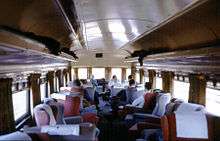Nebraska Zephyr
|
Postcard depiction of the Nebraska Zephyr in the 1950s. | |
| Overview | |
|---|---|
| Predecessor | Ak-Sar-Ben Zephyr |
| First service | November 16, 1947 |
| Last service | April 30, 1971 |
| Former operator(s) | |
The Nebraska Zephyr was a streamlined passenger train operated by the Chicago, Burlington and Quincy Railroad (CB&Q, commonly known by the shorter name of "Burlington") between Chicago, Illinois, Omaha, Nebraska and Lincoln, Nebraska. It operated from 1947 to 1971. Until 1968 the two original Twin Cities Zephyr articulated trainsets, the "Train of the Gods" and "Train of the Goddesses", operated the service and became synonymous with it. The Nebraska Zephyr was one of many trains discontinued when Amtrak began operations in 1971. The "Train of the Goddess" set is preserved at the Illinois Railway Museum in Union, Illinois.
History

The Burlington introduced the Nebraska Zephyr on the Chicago–Omaha–Lincoln route on November 16, 1947, replacing the Ak-Sar-Ben Zephyr.[1]:50 The Zephyr joined four other trains on the route: the Exposition Flyer, Denver Zephyr, Ak-Sar-Ben, and Fast Mail. On-board services included a parlor car, dining car, and cocktail lounge.[2] The trains operated on a daylight schedule between Chicago and Lincoln. Westbound #11 departed Chicago at 12:45 PM and arrived in Lincoln at 10:30 PM. Eastbound #12 departed Lincoln at 11:00 AM and arrived in Chicago at 8:45 PM. The 551-mile (887 km) trip took 9 hours 45 minutes, an average speed of 56 miles per hour (90 km/h).[3]
Although the Burlington removed the distinctive "Zephyr" trainsets in February 1968, the train continued to operate as the Nebraska Zephyr, albeit with reduced service. A June 1968 timetable advertised a "dinette coach" as the only amenity, and the running time had lengthened to 11 hours 30 minutes.[4] The Nebraska Zephyr lost its name prior to its discontinuance on April 30, 1971.[5]
Equipment
The twin Nebraska Zephyr trainsets were built in 1936 by the Budd Company as the second pair of Twin Zephyrs, built for service between Chicago and Minneapolis-St. Paul, both of which had cars named for classical deities. One trainset was known as the "Train of the Goddesses" and its cars were named Venus, Vesta, Minerva, Psyche, Ceres, Diana, and Juno. The other trainset was known as the "Train of the Gods" and its cars were named Apollo, Mars, Neptune, Cupid, Vulcan, Mercury, and Jupiter. Each consist included the following cars: cocktail lounge, two 60-seat coaches, a coach-dinette, dining car, a parlor car, and a parlor-observation car. Early typical motive power for these trains was provided by a pair of shovel-nose diesels named Pegasus (CB&Q #9904) and Zephyrus (CB&Q 9905).[6]:214
In their original configuration the two parlor cars, Diana and Mercury, had 19 seats and a private drawing room. In 1942, prior to the sets entering service as the Nebraska Zephyr, 42 standard seats replaced the parlor seats. The Burlington added two new baggage cars, the Argo and Olympus, to the trains in February 1948. Finally, cost-cutting in the 1960s led to several changes in the food service arrangements on the trains. In 1963 the Burlington removed the cocktail lounges from the Venus and Apollo, replacing them with 42 coach seats. In 1966 the dining cars Ceres and Vulcan were rebuilt as "cafeteria cars" featuring vending machines.[6]:214
The Burlington withdrew the sets from service in February 1968, though the Nebraska Zephyr continued to operate. The "Train of the Goddesses" arrived at the Illinois Railway Museum on September 21, 1968 and it has been in use by the museum since then; it is still operated on short runs on the Museum's substantial trackage, providing train enthusiasts and tourists with an experience reminiscent of the heyday of the Burlington's Zephyr service.[7] Burlington sold the "Train of the Gods" to Saudi Arabia, where it operated into the 21st Century.[8]:112
Gallery
 Nebraska Zephyr, 1968
Nebraska Zephyr, 1968 Zephyr coaches at Galesburg, 1968
Zephyr coaches at Galesburg, 1968 Zephyr coaches at Galesburg, 1968
Zephyr coaches at Galesburg, 1968 Zephyr observation car at Burlington, IA, 1968
Zephyr observation car at Burlington, IA, 1968 1967, CB&Q Nebraska Zephyr & Kansas City Zephyr @ Riverside, IL
1967, CB&Q Nebraska Zephyr & Kansas City Zephyr @ Riverside, IL 1967, CB&Q Nebraska Zephyr & Kansas City Zephyr @ Riverside, IL
1967, CB&Q Nebraska Zephyr & Kansas City Zephyr @ Riverside, IL
References
- ↑ Kratville, William (2002). Railroads of Omaha and Council Bluffs. Arcadia Publishing. ISBN 9780738520421. OCLC 51932124.
- ↑ "Nebraska Zephyr". Pittsburgh Press. December 3, 1947.
- ↑ Official Guide of the Railways. New York: National Railway Publication Co. March 1950. pp. 1027–1028. OCLC 6340864.
- ↑ Chicago, Burlington and Quincy Railroad (June 9, 1968). Burlington Timetable.
- ↑ "Passenger trains operating on the eve of Amtrak". Retrieved May 7, 2011.
- 1 2 Wayner, Robert J., ed. (1972). Car Names, Numbers and Consists. New York: Wayner Publications. OCLC 8848690.
- ↑ Illinois Railway Museum (May 5, 2005). "History of the IRM". Retrieved 2005-11-07.
- ↑ Zimmermann, Karl (2004). Burlington's Zephyrs. Saint Paul, MN: MBI. ISBN 0760318565. OCLC 55676175.
External links
| Wikimedia Commons has media related to Nebraska Zephyr. |
